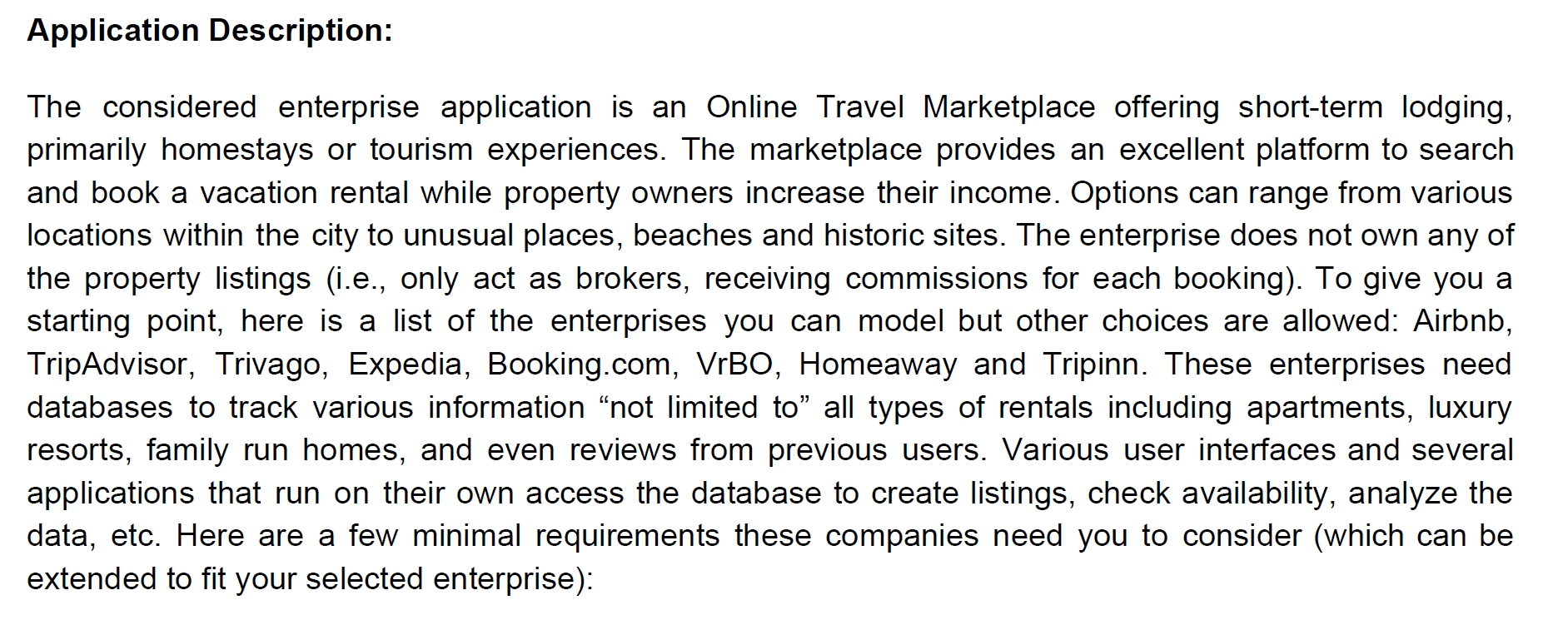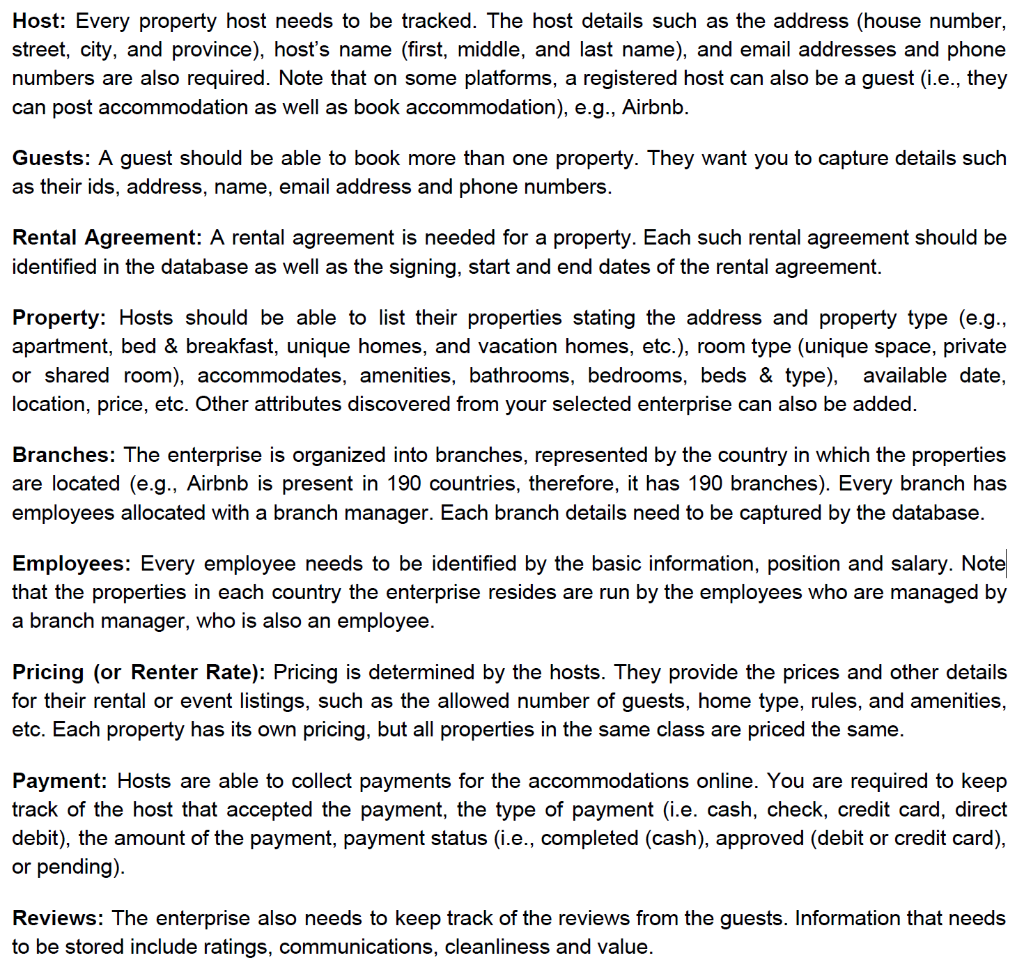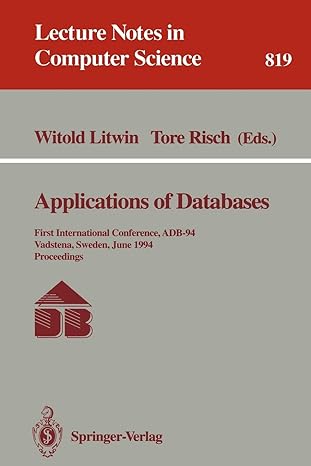Answered step by step
Verified Expert Solution
Question
1 Approved Answer
Construct an ER Diagram given the application description. E-R Model Construct an E-R diagram representing the conceptual design of the database. Since there are many



Construct an ER Diagram given the application description.
E-R Model Construct an E-R diagram representing the conceptual design of the database. Since there are many variations of the original version (which represented relationships as diamonds), you can use other forms you prefer, e.g., IDEFIX, IE CROW's foot model, etc. At a minimum, you must include all the entities and relationship sets implied, and they should not be assumed as completely identified under the project requirements. Be sure to identify the primary keys, relationship cardinalities, etc. You can make your design complete by studying the website of your selected online travel marketplace enterprise. Application Description: The considered enterprise application is an Online Travel Marketplace offering short-term lodging, primarily homestays or tourism experiences. The marketplace provides an excellent platform to search and book a vacation rental while property owners increase their income. Options can range from various locations within the city to unusual places, beaches and historic sites. The enterprise does not own any of the property listings (i.e., only act as brokers, receiving commissions for each booking). To give you a starting point, here is a list of the enterprises you can model but other choices are allowed: Airbnb, TripAdvisor, Trivago, Expedia, Booking.com, VrBO, Homeaway and Tripinn. These enterprises need databases to track various information not limited to all types of rentals including apartments, luxury resorts, family run homes, and even reviews from previous users. Various user interfaces and several applications that run on their own access the database to create listings, check availability, analyze the data, etc. Here are a few minimal requirements these companies need you to consider (which can be extended to fit your selected enterprise): Host: Every property host needs to be tracked. The host details such as the address (house number, street, city, and province), host's name (first, middle, and last name), and email addresses and phone numbers are also required. Note that on some platforms, a registered host can also be a guest (i.e., they can post accommodation as well as book accommodation), e.g., Airbnb. Guests: A guest should be able to book more than one property. They want you to capture details such as their ids, address, name, email address and phone numbers. Rental Agreement: A rental agreement is needed for a property. Each such rental agreement should be identified in the database as well as the signing, start and end dates of the rental agreement. Property: Hosts should be able to list their properties stating the address and property type (e.g., apartment, bed & breakfast, unique homes, and vacation homes, etc.), room type (unique space, private or shared room), accommodates, amenities, bathrooms, bedrooms, beds & type), available date, location, price, etc. Other attributes discovered from your selected enterprise can also be added. Branches: The enterprise is organized into branches, represented by the country in which the properties are located (e.g., Airbnb is present in 190 countries, therefore, it has 190 branches). Every branch has employees allocated with a branch manager. Each branch details need to be captured by the database. Employees: Every employee needs to be identified by the basic information, position and salary. Note that the properties in each country the enterprise resides are run by the employees who are managed by a branch manager, who is also an employee. Pricing (or Renter Rate): Pricing is determined by the hosts. They provide the prices and other details for their rental or event listings, such as the allowed number of guests, home type, rules, and amenities, etc. Each property has its own pricing, but all properties in the same class are priced the same. Payment: Hosts are able to collect payments for the accommodations online. You are required to keep track of the host that accepted the payment, the type of payment (i.e. cash, check, credit card, direct debit), the amount of the payment, payment status (i.e., completed (cash), approved (debit or credit card), or pending). Reviews: The enterprise also needs to keep track of the reviews from the guests. Information that needs to be stored include ratings, communications, cleanliness and value. E-R Model Construct an E-R diagram representing the conceptual design of the database. Since there are many variations of the original version (which represented relationships as diamonds), you can use other forms you prefer, e.g., IDEFIX, IE CROW's foot model, etc. At a minimum, you must include all the entities and relationship sets implied, and they should not be assumed as completely identified under the project requirements. Be sure to identify the primary keys, relationship cardinalities, etc. You can make your design complete by studying the website of your selected online travel marketplace enterprise. Application Description: The considered enterprise application is an Online Travel Marketplace offering short-term lodging, primarily homestays or tourism experiences. The marketplace provides an excellent platform to search and book a vacation rental while property owners increase their income. Options can range from various locations within the city to unusual places, beaches and historic sites. The enterprise does not own any of the property listings (i.e., only act as brokers, receiving commissions for each booking). To give you a starting point, here is a list of the enterprises you can model but other choices are allowed: Airbnb, TripAdvisor, Trivago, Expedia, Booking.com, VrBO, Homeaway and Tripinn. These enterprises need databases to track various information not limited to all types of rentals including apartments, luxury resorts, family run homes, and even reviews from previous users. Various user interfaces and several applications that run on their own access the database to create listings, check availability, analyze the data, etc. Here are a few minimal requirements these companies need you to consider (which can be extended to fit your selected enterprise): Host: Every property host needs to be tracked. The host details such as the address (house number, street, city, and province), host's name (first, middle, and last name), and email addresses and phone numbers are also required. Note that on some platforms, a registered host can also be a guest (i.e., they can post accommodation as well as book accommodation), e.g., Airbnb. Guests: A guest should be able to book more than one property. They want you to capture details such as their ids, address, name, email address and phone numbers. Rental Agreement: A rental agreement is needed for a property. Each such rental agreement should be identified in the database as well as the signing, start and end dates of the rental agreement. Property: Hosts should be able to list their properties stating the address and property type (e.g., apartment, bed & breakfast, unique homes, and vacation homes, etc.), room type (unique space, private or shared room), accommodates, amenities, bathrooms, bedrooms, beds & type), available date, location, price, etc. Other attributes discovered from your selected enterprise can also be added. Branches: The enterprise is organized into branches, represented by the country in which the properties are located (e.g., Airbnb is present in 190 countries, therefore, it has 190 branches). Every branch has employees allocated with a branch manager. Each branch details need to be captured by the database. Employees: Every employee needs to be identified by the basic information, position and salary. Note that the properties in each country the enterprise resides are run by the employees who are managed by a branch manager, who is also an employee. Pricing (or Renter Rate): Pricing is determined by the hosts. They provide the prices and other details for their rental or event listings, such as the allowed number of guests, home type, rules, and amenities, etc. Each property has its own pricing, but all properties in the same class are priced the same. Payment: Hosts are able to collect payments for the accommodations online. You are required to keep track of the host that accepted the payment, the type of payment (i.e. cash, check, credit card, direct debit), the amount of the payment, payment status (i.e., completed (cash), approved (debit or credit card), or pending). Reviews: The enterprise also needs to keep track of the reviews from the guests. Information that needs to be stored include ratings, communications, cleanliness and valueStep by Step Solution
There are 3 Steps involved in it
Step: 1

Get Instant Access to Expert-Tailored Solutions
See step-by-step solutions with expert insights and AI powered tools for academic success
Step: 2

Step: 3

Ace Your Homework with AI
Get the answers you need in no time with our AI-driven, step-by-step assistance
Get Started


